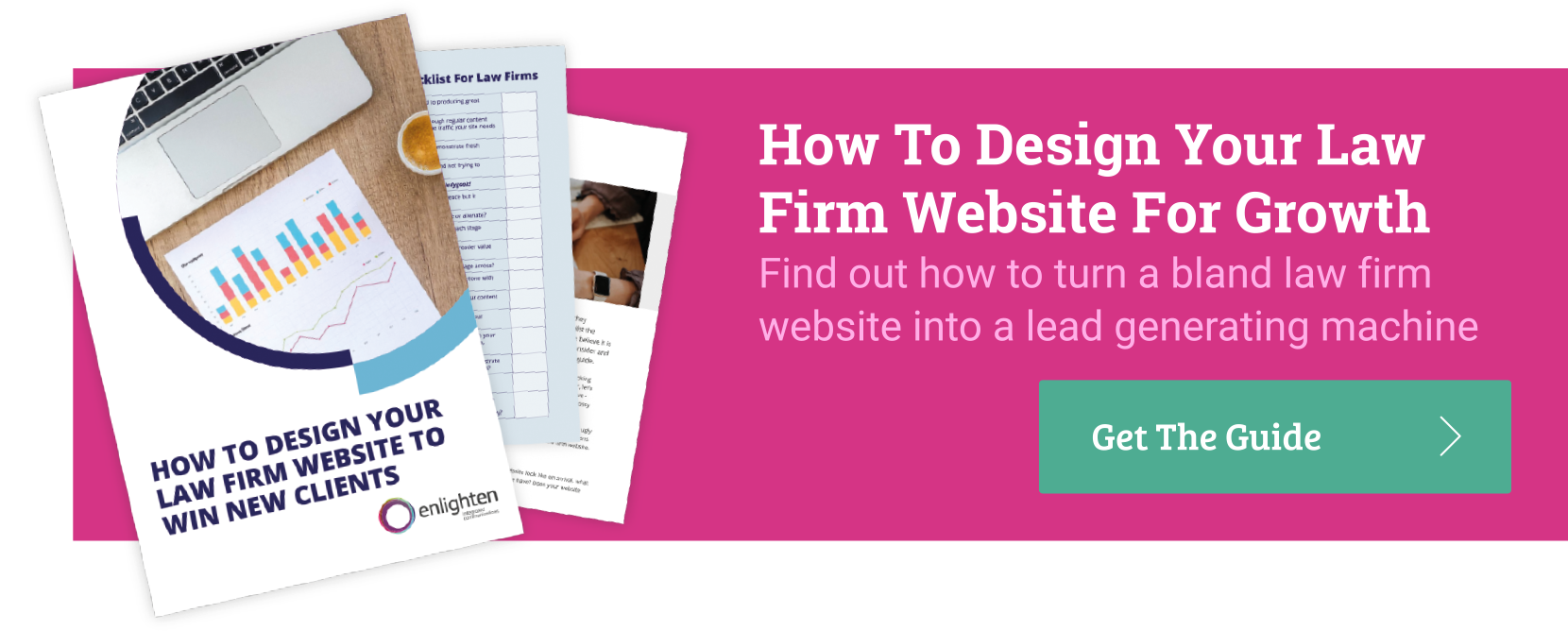
How To Grow Your Practice With Inbound Marketing For Solicitors
By John Hogg
Tags:
legal marketing law firm websiteCan Inbound Marketing for solicitors generate leads from your law firm website?
Lawyers love a good website... add a few nice visuals to the home page, post some pictures from a recent event at the firm, include your partners' bios and add a couple of legal updates regarding the latest changes in legislation and that's the job done... or is it?
If that’s what you would like from your website, no problem, we can do that for you - just get in touch and we can start today!
STOP!
Too good to be true?
Perhaps this all sounds too much and it’s just a cleverly disguised attempt to make a slick sales pitch to redesign your website?
Before we go any further let’s take things back a bit and ask a pretty fundamental question,
Which of the following answers apply?
- You don’t have a website.
- You have a website because you feel you have to have one but don’t really know why.
- You have one to add some credibility so that a prospective client can look at the website to read your bios, the experience you have and the awards you've won.
- You have a website at your law firm because it generates 'x' number of leads each month.
Presuming the fact you are reading this blog on how inbound marketing for solicitors can generate leads, is because you would like to be in the fourth category but just don't know how to do it?
Don't worry if your answer was 1, 2 or 3, because we're about to show you how to generate leads from your law firm website using inbound marketing.
So How Do You Generate Leads From A Law Firm Website?
The first trick is to stop thinking about what YOU want to say and start thinking about what it is your audience wants to hear.
Inbound marketing for solicitors is a relatively new concept in marketing and at its core it is pretty much common-sense. Instead of interrupting your audience and trying to force them to do business with you because you say you are great, inbound marketing at your law firm should be about understanding your audience, earning their attention and then converting these into leads through interesting and relevant content that addresses their particular problems and issues.
The main steps you need to take include:
- Knowing your audience.
- Understanding their pains and the challenges they face.
- Publishing relevant content to address their pains/ challenges.
- Optimising your content for search engines so that your audience can find it when they search for answers to their problems.
- Promoting your content through social media, email and even online ads such as Paid Search or Paid Social.
- Using "Call To Actions" throughout your website to introduce premium content for them to download.
- Using gated pages to acquire their email address in return for your premium content.
- Using email workflows once they download your content to nurture them until they are ready to become your client.
- Having a centralised CRM to manage all your contacts in one place.
There is no hard sell here!
Inbound Marketing Is A Bit Like Horses For Courses
An important point to remember is that everyone is at a different point in their journey to become a client of your law firm. You don't know what knowledge they already have or how serious they are about employing a law firm... never mind yours!
Each lead is a person at the end of the day and no matter how big the company is that they work for, they are still a person and they will need to satisfy their own requirements as they research solutions for the problems and challenges they face.
We typically see three main stages in a buyer's journey on their way to becoming a law firm client.
- The Awareness Stage
Are they just at the beginning of their journey and discovering they have an issue (pain) and are they starting to search online regarding this issue?
At this point you need to develop content that appeals to this stage of the buyer’s journey and helps them to define their problem.
There should be no mention of how you can help yet and definitely no mention of your services. - The Consideration Stage
Now that your prospects have identified the issue they have and searched for various answers online, they will move to the Consideration Stage.
At this point they are searching for a solution and your content will need to outline the various solutions that could answer these problems.
Please Note: there is still no mention of your services at this point! - Decision stage
The final stage in your prospect's journey to becoming a client is the Decision stage.
At this point your prospects are looking to purchase a solution to their pains so you will need to make sure that your content is focused on how "your firm" can help them.
Perhaps illustrations of what you have done for similar clients could help (think Case Studies)?
The important point to consider is that everyone travels through the buyer’s journey at different speeds. Some people will move through it in a day, others like to consider their options and work through at their own pace. For this reason you need to have content focussed on all three stages of the buyer’s journey on your website in order to cater for different visitors to your website who may be at each of these different stages.
Content Offers
Publishing content for each stage of the Buyer’s Journey will help you to appear more relevant to your audience and will also help to drive conversions into leads. The best way to do this is to have different types of offer for each type of content.
We don’t mean an actual offer to do business, we mean a Content Offer, such as an eBook or a White Paper for each stage of the Buyer’s Journey.
eBooks and White Papers work well for the Awareness and Consideration stages, whilst comparisons and case studies work well at the Decision stage.
Conversion path
You will want to add each lead to an email workflow which will nurture them with a series of automated emails to help them through their journey until they are ready to get on a call or meet with you to find out more about becoming a client.
By understanding your audience, the pains they suffer and providing them with the content which address these pains for the three main stages of the buyer’s journey, you will be well positioned to attract the right visitors to your website and convert them into leads.
Not bad for a humble law firm website which was previously languishing without much love or engaging content for so long. By taking a strategic approach and thinking deeply about what it is your target audience wants and refocusing your content "on them" instead of your firm, you will suddenly have a law firm website which stands out from the rest and even better than this, your website will be generating new leads and generating revenue for your firm.
If you like this blog, please feel free get in touch. You may also like to read our free guide, "How To Generate Leads From Your Law Firm Website" to get into more detail on how your practice can actually start to take an inbound approach to your law firm marketing.

John Hogg
John is managing director of Enlighten IC and has been involved in legal marketing and technology marketing for over 25 years. He is passionate about how an inbound approach to marketing can help firms to drive leads and grow their business.
Get In Touch

